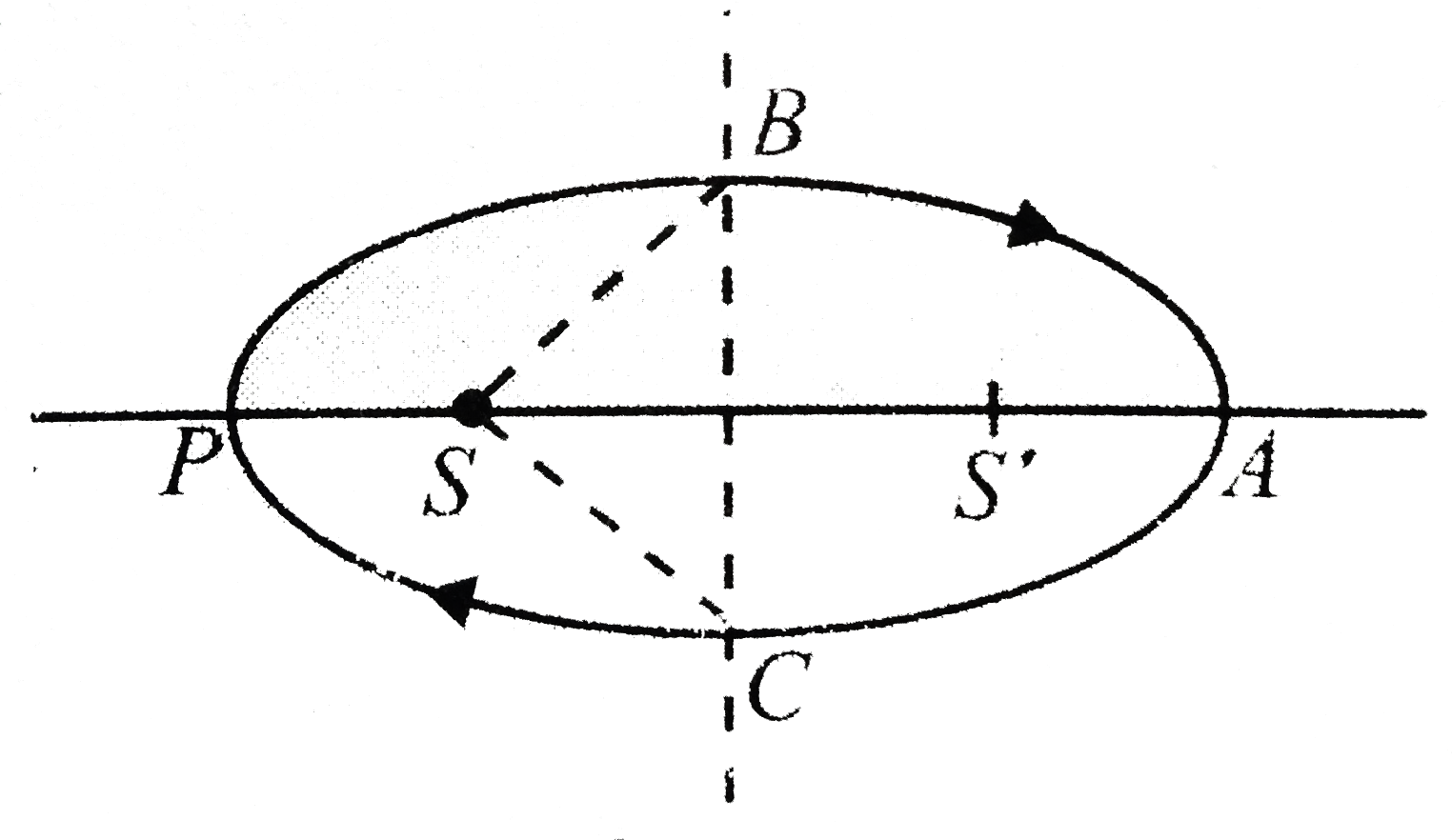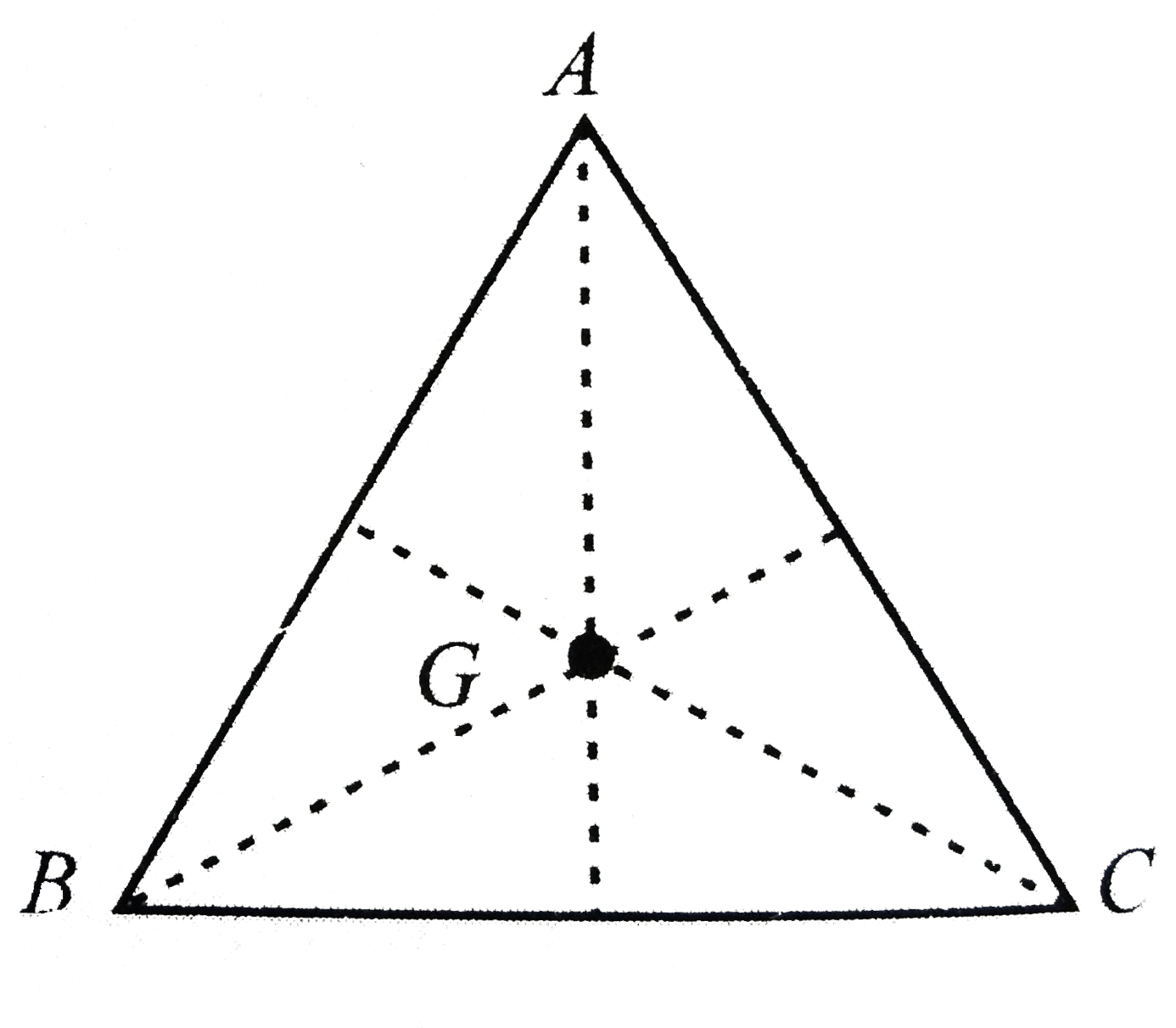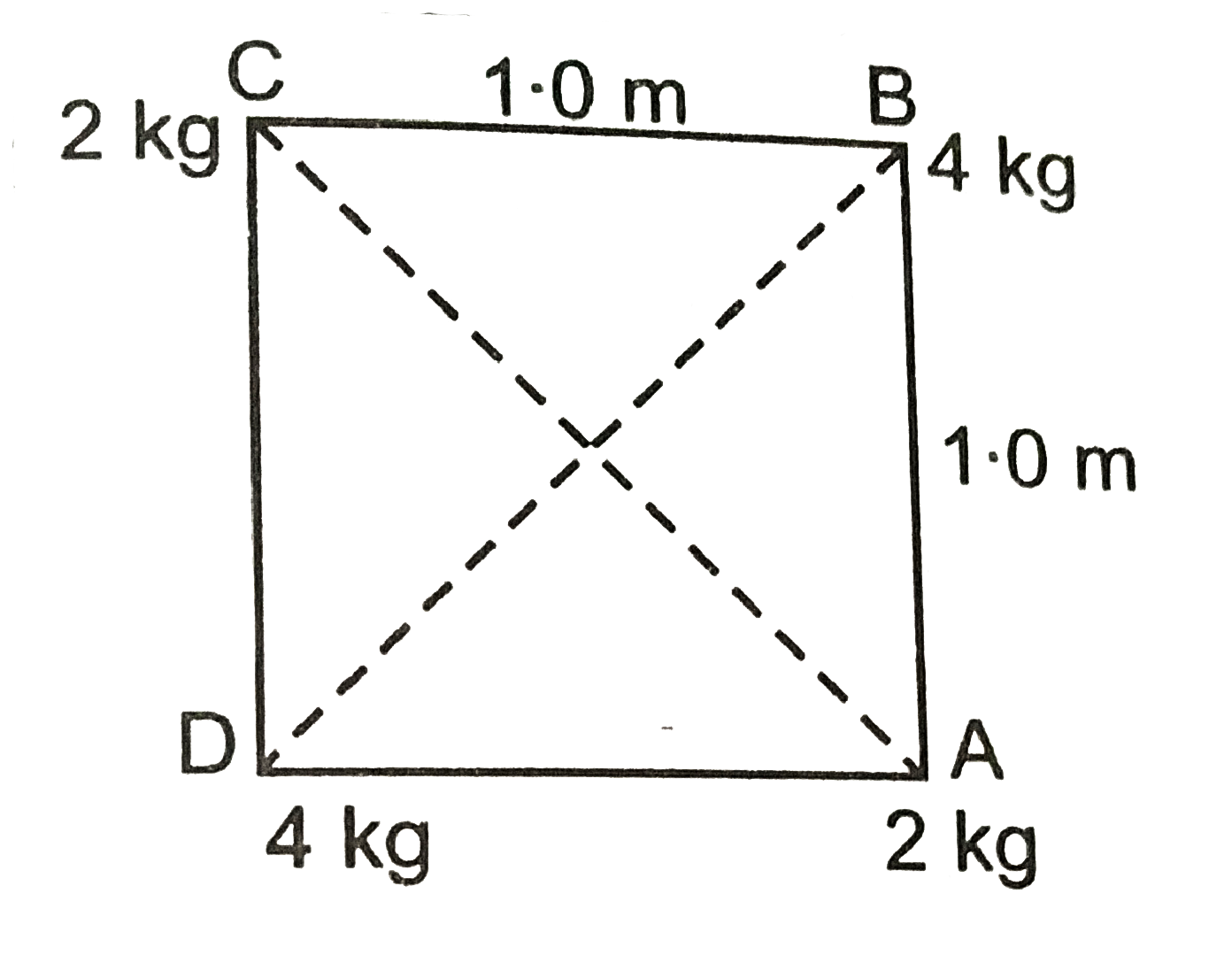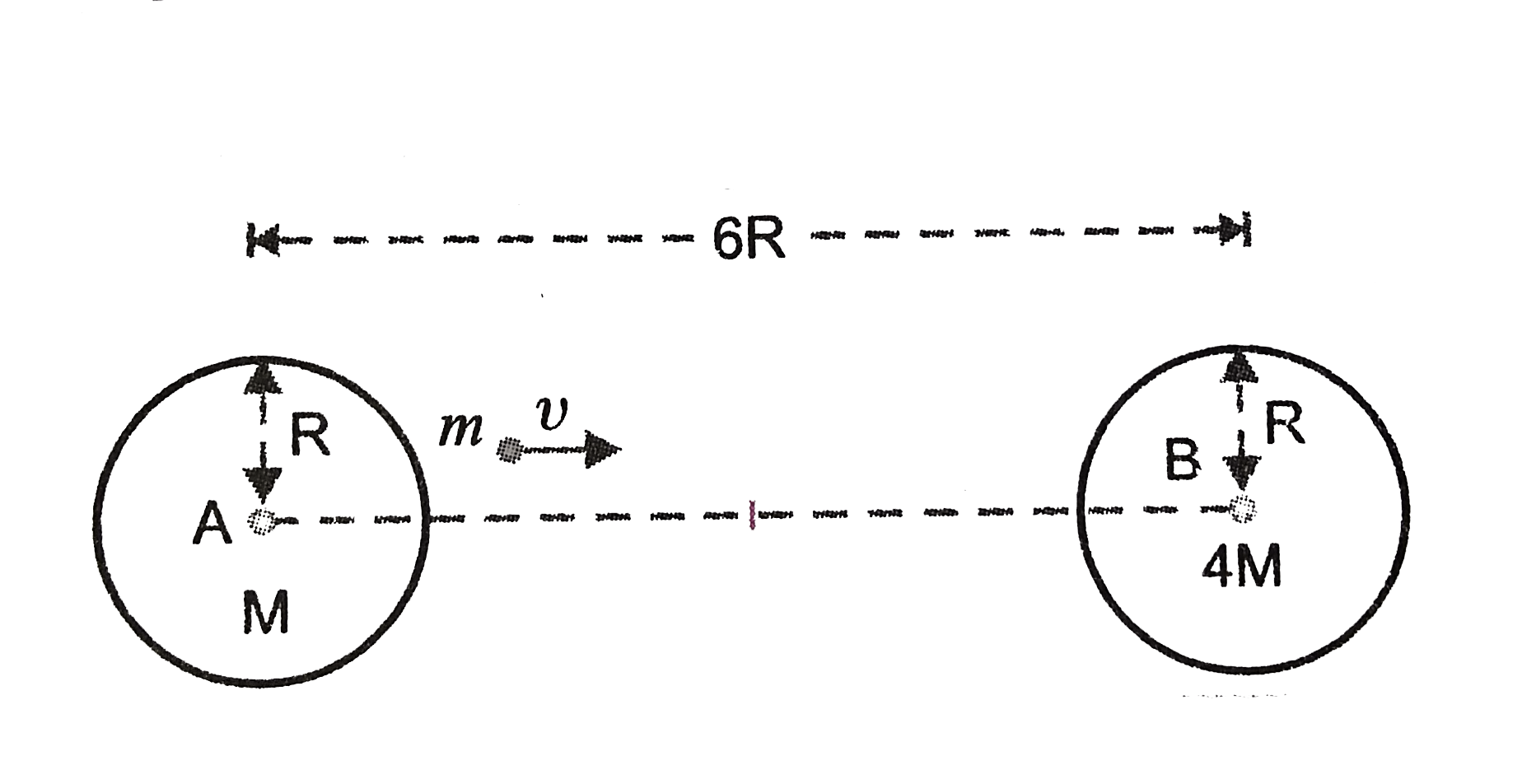Complete Solutions to SOLVED EXAMPLES of chapter GRAVIATION of Class 11 book with complete answers and questions
| Class 11 | PHYSICS |
| Chapter | GRAVIATION |
| PRADEEP | SOLVED EXAMPLES |
| Number Of Questions | 50 |
| Academic Year | 2023-24 |
A certain planet's year is `8` times the earth's year. Find the distance of this planet from the sun if the distance of the earth is `1 AU` from the sun.
01:57View SolutionLet the speed of the planet at the perihelion `P` in figure be `v_(P)` and the Sun planet distance `SP` be `r_(P)`. Relater `r_(P), v_(P)` to the corresponding quantities at the aphelion `(r_(A),v_(A))`. Will the planet take equal times to transverse `BAC` and `CPB`?
 03:05View Solution
03:05View SolutionGiven that `T^(2) = kR^(3)`, express the constant `k` of the above relation in days and kilometres. Given, `k= 10^(-13)s^(2) m^(-3)`. The Moon is at a distance of `3.84 xx 10^(5) km` from the earth. Obtain its time period of revolution in days.
02:39View SolutionAccording to kepler's law of periods, `T^(2) = k r^(3)`, where `k` is a constant. Compute the constant `k` for (a) the earth and (b) the venus. Given that orbital radii of the earth and the venus are `1.496 xx 10^(11) m` and `1.082 xx 10^(11) m`, and their respective periods are 1 year and `0.615` year.
02:49View SolutionIf the Earth be at one fourth its present distance from the sun, how many days will be charged in present one year on the surface of earth?
01:57View SolutionThe centres of two identical spheres are `50 cm` apart. If the gravitational force between the spheres be `4.0 N`, find the mass of each sphere. Given, `G = 6.67 xx 10^(-11) Nm^(2)kg^(-2)`.
01:46View SolutionThe mass of planet Jupiter is `1.9xx10^(27)kg` and that of the Sun is `1.99xx10^(30)kg`. The mean distance of Jupiter from the Sun is `7.8xx10^(11)`m. Calculate the gravitational force which Sun exerts on Jupiter. Assuming that Jupiter moves in circular orbit around the Sun, also calculate the speed of Jupiter `G=6.67xx10^(-11)Nm^(2)kg^(-2)`.
03:33View SolutionThe distance between earth and moon is `3.8 xx 10^(8)m`. Determine the gravitational potential energy of earth-moon system. Given, mass of the earth `= 6 xx 10^(24) kg`, mass of moon `= 7.4 xx 10^(22)kg` and `G = 6.67 xx 10^(-11) Nm^(2) kg^(-2)`
01:30View SolutionHow far from Earth must a body be along a line joining the sun to the earth so that resultage gravitational pull on the body due to Earth and sun is zero ? Distance between sun and the Earth is `1.5 xx 10^(8) km`. Mass of sun `= 3.25 xx 10^(5)` times mass of Earth.
03:59View SolutionThree equal masses of `m kg` each are fixed at the vertices of an equilateral triangle `ABC`.
a. What is the force acting on a mass `2m` placed at the centroid `G` of the triangle?
b. What is the force if the mass at the vertex `A` is doubled? Take `AG=BG=CG=1m`
 09:50View Solution
09:50View SolutionThree identical particles each of mass "m" are arranged at the corners of an equiliteral triangle of side "L". If they are to be in equilibrium, the speed with which they must revolve under the influence of one another's gravity in a circular orbit circumscribing the triangle is
07:56View SolutionAssuming the earth of to be a uniform sphere of radius `6400 kg` and density `5.5 g//c.c.`, find the value of `g` on its surface. `G=6.66xx10^(-11)Nm^(2)kg^(-2)`
03:10View SolutionIf the radius of the earth be increased by a factor of `5`, by what factor its density be changed to keep the value of `g` of the same?
02:29View SolutionA planet whose size is the same and mass is `4` times as that of Earth, find the amount of energy needed to lift a `2 kg` mass vertically upwards through `2m` distance on the planet. The value of `g` on the surface of Earth is `10 ms^(-2)`.
02:16View SolutionA man can jump `2.0 m` high on the earth. Up to what height he can jump on a planet whose density is one quarter that of Earth and radius in one-third of the Earth's radius.
06:43View SolutionIf the radius of the Earth shrinks by `2%`, mass remaing same, then how would the have of acceleration due to gravity change?
04:47View SolutionTwo lead spheres of `20 cm` and `2 cm` diametre respectively are planet with centres `100 cm` apart. Calculate the attraction between them, given the radius of the Earth as `6.37 xx 10^(8) cm` and its mean density as `5.53 xx 10^(3) kg m^(-3)`. Speciffic gravity of lead `= 11.5`. If the lead spheres are replaced by bress sphere of the same radii, would the force of attraction be the same?
09:46View SolutionAt what height from the surface of earth will the value of g be reduced by `36%` from the value on the surface? Take radius of earth `R = 6400 km`.
01:30View SolutionA body weighs `64 N` on the surface of Earth. What is the gravitational force on it due to the earth, at a height equal to half the radius of Earth ? Acceleration due to gravity on the surface of Earth is `10 m s^(-2)`.
02:27View SolutionFind the percentage decrease in the wight of the body when taken to a heigh of `16 km` above the surface of Earth. Radius of the earth is `6400 km`.
03:12View SolutionA body hanging from a spring stretches it by `2 cm` at the earth's surface. How much will the same body stretch the spring at a place `800 cm` above the earth's surface? Radius of the earth is `6400 km`.
04:14View SolutionAn object weighs `10 N` at north pole of Earth. In a geostationary satellite distance `7 R` from centre of Earth (of radius `R`), what will be its (a) true weight (b) apparent weight?
03:20View SolutionAt what depth from the surface of earth, the value of acceleration due to gravity is reduced by `40%` of its value on the surface of earth. Radius of the earth `= 6.4 xx 10^(6) m`.
01:33View SolutionAssuming the Earth to be a sphere of uniform mass density, how much would a body weight half way down to the centre of the Earth, if it weighed `300N` on the surface of Earth.
02:00View SolutionFind the percentage decrease in the weight of the body when taken `64 km` below the surface of the Earth. Take redius of the Earth `= 6400 km`.
02:07View SolutionDetermine the speed with which the earth would have to rotate on its axis , so that a person on the equator would weigh `(3)/(5)` th as much as the person. Take `R = 6400 km`.
01:59View SolutionCalculate that imaginary angular velocity of the Earth for which effective acceleration due to gravity at the equator becomes zero. In this condition, find the length (in hours) of a day? Radius of Earth `= 6400 km. g = 10 ms^(-2)`.
02:04View SolutionSuppose Earth is perfect sphere of radius `6.4 xx 10^(6) m`. It is rotating about its polar axis with a period of `1` day. What is the difference in the value of acceleration due to gravity on pole and at a place of latitude `60^(@)`?
03:12View SolutionDetermine the gravitational potential on the surface of earth, given that radius of the earth is `6.4 xx 10^(6) m`: its mean density is `5.5 xx 10^(3)kg m^(-3) , G = 6.67 xx 10^(-11) Nm^(2) kg^(-2)`.
01:55View SolutionTwo masses `800 kg `and `600 kg` are at a distance `25 cm` apart. Compute the magnitude of the intensity of the gravitational field at a point disatnce `20 cm` from the `800 kg` mass and `15 cm` frm the `600 kg` mass
`G = 6.66 xx 10^(-11) Nm^(2) kg^(-2)`.04:43View SolutionAt a point above the surface of Earth, the gravitational potential is `-5.12 xx 10^(7) J kg^(-1)` and the acceleration due to gravity is `6.4 ms^(-2)`. Assuming the mean redius of the earth to be `6400 km`, calcualte the height of this point above the Earth's surfcae.
02:52View SolutionThree particles, each of mass `m` are placed at the vertices of an equilateral triangle of side `a`. What are the gravitation field and gravitational potential at the centroid of the triangle.
View SolutionA point mass body of mass `2 kg` is placed at a distance `20 cm` from one end of a uniform rod of length `2 m` and mass `10 kg`. Calculate
(i) gravitational intensity at the location of point mass body due to the rod.
(ii) gravitational force on the body due to the rod. Use `G = 6.67 xx 10^(-11) Nm^(2) kg^(-2)`.04:09View SolutionA body is released from a point of distance `R'` from the centre of earth. Its velocity at the time of striking the earth will be `(R’gtR_(e))`
02:09View SolutionWhat is the minimum energy required to launch a satellite of mass m from the surface of a planet of mass M and radius R in a circular orbit at an altitude of 2R?
02:33View SolutionFour point mass bodies of masses as shown in Fig. are placed at the vertices of a square `ABCD`, gravitational force on the body at `A`. Given, `G = 6.6 xx 10^(-11) Nm^(2) kg^(-2)`
 04:40View Solution
04:40View SolutionA satellite revolves in an orbit close to the surface of a planet of mean density `5.51 xx 10^(3) kg m^(-3)`. Calculate the time period of satellite.
Given `G = 6.67 xx 10^(-11) Nm^(2) kg^(-2)`.03:18View SolutionAn Earth satellite has time percircular, calculate its height. Given, radius Earth `= 6380 km, g` at the surface of Earth `= 9.8 ms^(-2)`.
01:32View SolutionYou are given the following data `:g=9.81ms^(-2)`, radius of earth `=6.37xx10^(6)m` the distance the Moon from the earth `=3.84xx10^(8) m` and the time period of the Moon's revolution `=27.3days`. Obtain the mass of the earth in two different ways. `G=6.67xx10^(-11)Nm^(2)kg^(2)`.
04:11View SolutionAn artifical satellitee of mass `100 kg` is in a circular orbit at `500 km` above the Earth's surface. Take redius of Earth as `6.5 xx 10^(6) m`.(a) Find the acceleration due to gravity at any point along the satellite path (b) What is the centripetal acceleration o fthe satellite?
03:29View SolutionCalculate (i) kinetic energy (ii) potential energy and (iii) total energy of a satellite of mass `200 kg` orbiting around the earth in an orbit of height `100 km` from the surface of earth. Given, mass of earth `= 10^(25) kg`,radius of earth `= 6.4 xx 10^(6) m, G = 6.67 xx 10^(-11) Nm^(2) kg^(-2)`.
03:08View SolutionIn a two stage launch of a satellite, the first stage bringe the satlilte to a height of `500 km` and the second stage given it the necessary critical speed to put it in circular orbit around the Earth. Which stage requires more expenditude of fuel?
(Neglect damping due to air resistance, especially in the first stage).
Mass of the Earth `= 6.0 xx 10^(24) kg`,radius of Earth `= 6400 km, G = 6.67 xx 10^(-11) Nm^(2) kg^(-2)`.04:16View SolutionDetermine the escape speed of Moon. Given, the radius of Moon is `1.74 xx 10^(6) m`, its mass is `7.36 xx 10^(22) kg`. Does your answer throw light on why the moon has no atmosphere?
`G = 6.67 xx 10^(-11) n m^(2) kg^(-2)`.03:09View SolutionJupiter has a mass `320` times that of the earth and its readius is `11.2` times that of the earth. Determine the escape velocity from the surface of jupiter, given that the escape velocity from the surface of earth is `11.2 km s^(-1)`.
01:45View SolutionA block hole is a body from whose surface nothing may even escape. What is the condition for a uniform spherical body of mass `M` to be a block hole? What should be the radius of such a black hole if its mass is nine times the mass of the earth?
Mass of earth `= 6xx 10^(24)kg`,
`G = 6.61 xx 10^(-11) Nm^(2) kg^(-2)`.02:21View SolutionCalculate the minimum speed required by a rocket to pull out of the gravitational force of Mars. Given that the earth has a mass `9` times and radius twice of the planet Mars. Escape speed on the surface of earth is `11.2 km s^(-1)`.
01:51View SolutionTwo bodies of masses `m_(1)` and `m_(2)` are placed at a distance `r` apart. Show that the position where the gravitational field due to them is zero, the potential is given by
`-G (m_(1) + m_(2) + 2 sqrt(m_(1) + m_(2)))//r`03:36View SolutionTwo uniform soild spheres of equal radii `R` but mass `M` and `4M` have a centre to centre separation `6 R`, as shows in Fig. (a) The two spheres are held fixed. A projectile of mass `m` is projected from the surface of the sphere of mass `M` directly towards the centre of ten second. Obtain an expression for the minimum speed `upsilon` of the projectile so that it reaches the surface of second sphere.
 13:19View Solution
13:19View SolutionThe planet Mars has two moons. Phobos and Delmos (i) phobos has period `7` hours, `39` minutes and an orbital radius of `9.4 xx 10^(3) km`. Calculate the mass of Mars. (ii) Assume that Earth and mars move in a circular orbit around the sun, with the martian orbit being `1.52` times the orbital radius of the Earth. What is the length of the martian year in days? `(G = 6.67 xx 10^(-11) Nm^(2) kg^(-2))`
04:42View SolutionIf a satellite is revolving around a planet of mass `M` in an elliptical orbit of semi-major axis `a`. Show that the orbital speed of the satellite when it is a distance `r` from the focus will be given by
`upsilon^(2) = GM[(2)/(r ) - (1)/(a)]`03:12View Solution
SOLVED EXAMPLES questions and complete solutions for chapter GRAVIATION of PRADEEP PHYSICS (HINGLISH) of Class 11
All Exercises from PRADEEP Class 11 PHYSICS GRAVIATION
- ADDITIONAL EXERCISES
- ADVANCED PROBLEMS FOR COMPETITIONS
- Assertion-Reason Type Questions
- CONCEPTUAL PROBLEMS
- CONCEPTUAL PROBLEMS I.
- CONCEPTUAL PROBLEMS II.
- CONCEPTUAL PROBLEMS III.
- CONCEPTUAL PROBLEMS IV.
- CONCEPTUAL PROBLEMS V.
- CURIOSITY QUESTION
- FILL IN THE BLANKS
- FOCUS Multiple Choice questions I.
- Integer Type Questions
- LONG ANSWER QUESTIONS
- MULTIPLE CHOICE QUESTIONS
- MULTIPLE CHOICE QUESTIONS -II
- Multiple Choice questions II.
- Multiple Choice questions III.
- Multiple Choice questions IV.
- Multiple Choice questions V.
- NCERT
- NCRET MULTIPLE CHOICE QUESTIONS -I
- PROBLEMS FOR PRACTIVE
- PROBLEMS FOR PRACTIVE A
- PROBLEMS FOR PRACTIVE B
- PROBLEMS FOR PRACTIVE C
- PROBLEMS FOR PRACTIVE D
- PROBLEMS FOR PRACTIVE E
- PROBLEMS FOR PRACTIVE F
- PROBLEMS FOR PRACTIVE G
- PROBLEMS FOR PRACTIVE H
- PROBLEMS FOR PRACTIVE I
- PROBLEMS FOR PRACTIVE J
- PROBLEMS FOR PRACTIVE K
- QUESTIONS
- Sample Problem
- SHORT ANSWER QUESTIONS
- SHORT ANSWER QUESTIONS I.
- SHORT ANSWER QUESTIONS II.
- SHORT ANSWER QUESTIONS III.
- SHORT ANSWER QUESTIONS IV.
- SHORT ANSWER QUESTIONS V.
- SOLVED EXAMPLES
- SOLVED EXAMPLES TYPE A
- SOLVED EXAMPLES TYPE B
- SOLVED EXAMPLES TYPE C
- SOLVED EXAMPLES TYPE D
- SOLVED EXAMPLES TYPE E
- SOLVED EXAMPLES TYPE F
- SOLVED EXAMPLES TYPE G
- SOLVED EXAMPLES TYPE H
- SOLVED EXAMPLES TYPE I
- SOLVED EXAMPLES TYPE J
- SOLVED EXAMPLES TYPE K
- VALUE BASED QUESTIONS
- VERY SHORT ANS. QUESTIONS
- VERY SHORT ANS. QUESTIONS I.
- VERY SHORT ANS. QUESTIONS II.
- VERY SHORT ANS. QUESTIONS III.
- VERY SHORT ANS. QUESTIONS IV.
- VERY SHORT ANS. QUESTIONS V.
- VERY SHORT ANSWER QUESTIONS
